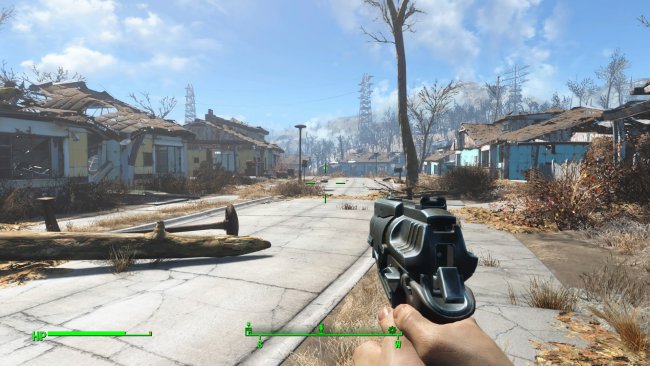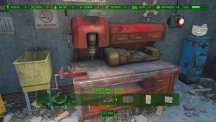The Fallout series is immensely popular and for the most part the games have been impeccable. But as Fallout 4 was presented at E3 the thing that probably got people just as excited as the prospect of the game itself was the fact that it was coming out this year. Just five months after its announcement we’re ready to hand out our verdict on the game. Having spent a majority of our waking hours playing the game for a week on PS4 we’re ready to let you know whether it lives up to our lofty expectations.
Before we dig into the game proper we’re forced to endure a rather lengthy installation that takes about twenty minutes. Thankfully, brief S.P.E.C.I.A.L. trailers help pass the time (you may have already seen these trailers here on Gamereactor). It should be noted that this was pretty much the only time we grew impatient with the game. Post-installation we’re treated to load times of the brevity that Bethesda are known for, so it’s a price we’re more than willing to pay.
The game starts as it should with the familiar words: “War … War never changes,” followed by a brief introduction of the game universe as it appears in the year 2077. The voice of a “potential protagonist” tells us about going to war and how advances in technology have made the world a more comfortable place to live. Now there are probably two things that those of you will have likely noticed in that sentence, namely ‘potential protagonist’ and ‘tell’. The fact is that in Fallout 4 you can choose to play as either the man or the woman in a small family, and the developers have chosen to give both of these characters voices. The fact that your character now speaks has been a point of controversy among many fans, as they feel that you can’t immerse yourself in the same way compared to if you’re selecting a dialogue option from a text box, imagining the voice in your head. The decision has resulted in much more cinematic dialogue, which is very similar to what we have seen before from BioWare’s Mass Effect and Dragon Age games, and it works really well. Dialogue options have also been cut down to four choices for each answer you give, but it doesn’t feel like a limitation since each option is so different, and thus you can still choose to be sarcastic, clever, evil or suspicious, and good voice acting throughout the entire game makes the pleasure of having a conversation comparable to picking off the heads of mutant dogs.
The character creation takes place while looking in the mirror during the introductory phase of the game, and you also pick your starting stats in an appropriate manner, which we’ll not spoil here. You’ll also name your character and the developers have spoken at length about how they have incorporated pronunciation of different names into the game, so you’ll be able to hear your name integrated into the dialogue. It worked well in our case, but during our play-through we only met a solitary character who took advantage of the system. The use of it isn’t widespread, a pity as it seemed very promising. Having created a character through countless choices, you get a little more background to the story while walking about in your small house with your wife or husband, child and robot butler. This idyllic suburban life doesn’t last long, as the bombs start to drop. From the window of your home you can see mushroom clouds rising on the horizon. As instructed you grab your significant other and child, and flee to a nearby shelter, which, thanks to previous military service you’ve have been given a place in. You barely make it to safety before a bomb lands nearby. Welcome to Vault 111.


We’ll hold back on revealing any more of the story as it’s filled with twists and surprises, something you won’t want us spoiling. The only thing we will say is that not everything is what it seems and before you know it 200 years have passed, and you must leave the bunker to retrieve something invaluable. How it’s possible that you’re still alive after so many years, and what exactly it is that you’re looking for, well, we’ll leave you to find that out for yourselves.
It’s obviously a major upheaval to leave the safety of the vault behind and step out into the devastated Boston suburb where you lived with your family two centuries ago. Fortunately it’s not long until you meet a familiar face in the shape of your old robot butler, Codsworth. He’s able to tell you about the state of the world and offer some advice. He also serves as one of the many companions found in the game, and these work far better than in previous entries. They hit what they aim for most of the time, and at worst they will be knocked out in battle so they won’t die (forcing you to boot up a previous save in order to keep them alive in past games). Each companion also has unique abilities. One example is Dogmeat, who was unveiled during the announcement of the game, and he can grab onto enemies making them easier to hit. The various companions also offer up amusing observations about the world and the situations you find yourself in, and of course, they also serve as an extra backpack when you get overburdened. It’s nice that companions are truly useful for once, and besides being very helpful in combat, a good relationship with your companion also results in bonuses in the form of special perks.
The game’s perk system is better than ever. It’s straightforward and easy to understand, and its presentation is both funny and relevant. It’s all based on your S.P.E.C.I.A.L. stats, which stands for Strength, Perception, Endurance, Charisma, Intelligence, Agility and Luck. Each point invested in one of these categories has both a direct effect on your character’s abilities, and gives access to more perks in the corresponding branch. If, for example, you want to have 20% discount on all your purchases, it requires a certain number of Charisma points, and the further down the branch, the higher Charisma you must have. If you another 40% discount, it requires that your character has a certain level, and as certain perks have between two and up to six levels, it may require quite a lot of levelling if you want to specialise in a single branch. Every new level gets you one point which can either be used on perks or on your S.P.E.C.I.A.L. stats, so you have to constantly consider where to focus. There are also plenty of quirky and amusing perks, and a few very useful ones towards the end of the individual branches, such as the ability to get enemies to stop attacking by calling them and getting them to change allegiance and start fighting on your side. There’s a lot to explore, and since there is no level cap, it would theoretically be possible to unlock the entire tree, but it might take a very long time to do so.


In any RPG it’s naturally extremely important that the various quests are entertaining, and the developers have done a fantastic job in this regard. There’s a myriad of side quests that can be tackled for the different individuals and groups that you run into on your journey, and the vast majority of them are quite unique, and have numerous ways you can solve them. What we missed when it came to the quest system was a way to distinguish between the main quests and the side content. It can be a little difficult to figure out whether the individual quests are actually a part of the main story progression, especially after many hours and with your quest logs filled to the brim. There are also a few quests that are repeated from time to time, such as a person needing help to save a family member who has been taken hostage, or a factory that needs to be cleared of raiders. These standard missions are fortunately only associated with the different factions you can choose to support in the game, and they work as a means of increasing the said faction’s influence on the game world, which then frees camps and areas where you can subsequently build small shelters to host the population of the wasteland.
Building small towns and places of residence plays a significant role in Fallout 4 and this new feature came as a surprise to many when the game was first unveiled. There has been much curiosity about how freely you can build in the game world and how it all works, but we can reassure you that the game does a very fine job of explaining it. There are certain areas in the world in which it’s possible to build, and these are sectioned off by a greenish wall when viewed in build mode. All building requires resources, and these are obtained by collecting various objects during your adventure. This means a multitude of mundane objects in the game – such as forks, toy cars and cigarette packs – can be used for more than simply swapping for caps. A cigar box means wood and a tin can means metal, and if you gather the items needed to build something quite specific this item can be tagged in the construction menu, so it’s clear when you’re out gathering whether it’s an item you have use for or not. The more people who settle in your camp, the more beds and the more food it requires, and if you want the population to continue to grow you’ll need to equip it with lookout points and weapon turrets so raiders are not tempted to plunder your settlement. It’s also possible to build stores in the camps, meaning caravans will come by with new products, so you can fill up on weapons and ammunition. The whole system is very well put together, and we can imagine that many players will want to spend a lot of time on this part of the game, not least because it can be a great advantage to have easy access to shops and workbenches; something that’s key to your success in the game.
Workbenches in Fallout 4 can be used to improve equipment and weapons, and this time around the system is deeper than ever before. Each weapon can be equipped with unique enhancements such as scopes and silencers, and your armour can be given extra pockets so you can carry more, or can be made more resistant to certain bullet types. One’s armour consists of more individual parts, each arm and leg given its own piece of protection, so you can really find the right gear out in the wilderness, and investing wisely means you can build and modify your equipment to the point where it’s extremely effective. The acquisition of materials for the improvement of equipment works in exactly the same way as the town building, and it’s quite simple to tag a certain item you want to build in the menu, and thus you can easily find the materials you need. It must be said that improving your equipment is optional, as you often find better equipment on downed enemies, especially later in the game when you’re out in the wilds, but you never know exactly what you’ll find, so there’s no guarantee that it’s going to be something you can use. Some elite enemies also have specialised equipment and weapons, items which have bonuses you can’t add yourself, so it can often be worth hunting down opponents with an asterisk next to their name, although they can be hard to take down.
It’s not just the visuals that have taken a giant leap in the right direction, but the controls have also been totally overhauled. Since the game’s announcement it has emerged that Bethesda has been helped by developers from other studios (including Doom and Quake creators Id Software) to improve the in-game shooting system, and it definitely works better now and it’s possible to actually aim your weapon should you want to, and not just use the VATS system (where time is slower and you can select areas on the enemy to target with individual shots). The gunplay also works perfectly when played in the third-person, and for those who prefer to view the wasteland from that perspective, it’s a valid alternative should you wish.
One point that seems to have worried many fans is the size of the world map, which true enough isn’t as large as we’ve seen from other recent open-world games. However, we wouldn’t call the area too small, and the developers have managed to create a much more vibrant game world than before, with more interior spaces and diversified environments. At the end of the day we shouldn’t measure the size of this game by how long it takes us to run from one side of the map to the other, but instead on the depth that it offers; there is so much to take in and explore, with something new to discover down every single alley, inside every ramshackle factory building, and down in the darkness of the caves that are dotted around the world.
Fallout 4 has been much anticipated and there’s been growing excitement and towering expectations building around it, but this is a game that lives up to the hype. It absolutely delivers. The amount of content is overwhelming, and every part of the game feels complete, from building cities through to exchanging fire with the bandits found in the wilderness. The story is also pretty good, with lots of little surprises and difficult choices that must be made along the way, and the whole journey feels a very personal adventure, one where you have a lasting impact on the world around you. The improved management and upgraded graphics only serve to make the title even better than its predecessors, and we’ve no doubt that we’re dealing with a game that will end up at the top of many people’s game of the year shortlists.





